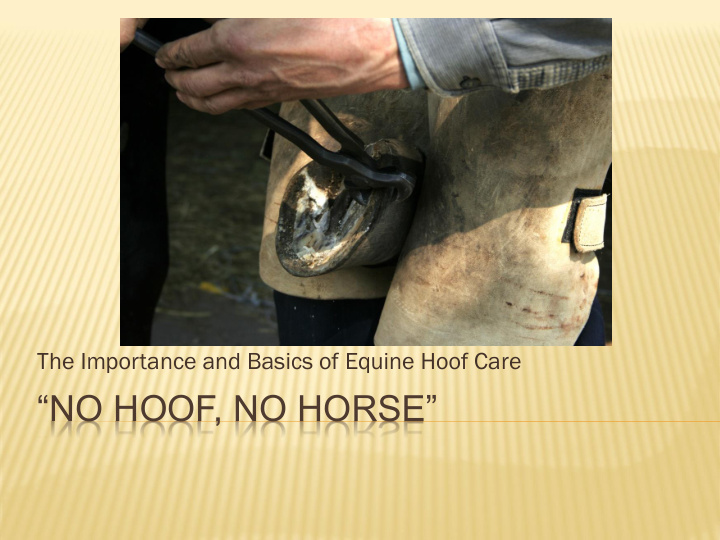



The Importance and Basics of Equine Hoof Care “NO HOOF, NO HORSE”
ARCADIA BIRKLID Hoof Matters – Certified Farrier Services AAPF Accredited Professional Farrier AFEC Certified Farrier 8 years of practice in Whatcom County Continuing Education Yearly Dressage Rider
WHY IS HOOF CARE IMPORTANT? Regular/Therapeutic hoof care enables the horse to stay sound to complete the job it is being asked to do Conformational defects pre-dispose a horse to injuries over the course of a lifetime, and proper hoof care can help manage/delay potential issues Keeping horses on a schedule helps to catch problems early
WHY IS HOOF CARE IMPORTANT? Hoof Energy Video
WHY IS HOOF CARE IMPORTANT? A horses foot travels 2 ½ times the speed of the horse – A thoroughbred may be traveling at 30mph, his foot is traveling at 75mph The foot on a Thoroughbred racehorse will accelerate to 75mph and decelerate to 0mph, impact the ground and then accelerate to 75mph again – two to three times PER SECOND!
ANATOMY OF THE HOOF The equine hoof is a feat of engineering,comprised of: Insensitive Structures Sensitive Structures Bones Tendons/Ligaments Intricate blood supply
INSENSITIVE STRUCTURES Things we can see from the outside Exterior Hoof Capsule Hoof Wall Periople (at Coronary or Coronet Band)
INSENSITIVE STRUCTURES Insensitive Structures (ground plane) Insensitive Sole Insensitive Frog White Line Divided into Three Zones Toe Quarter Heel
PARTS OF THE HOOF Wall White line White Line Sole Frog/Apex of Frog Bars Buttress of the Heels Buttress of Bulb of the Heels the Heel Central Sulcus Lateral Sulcus
SENSITIVE STRUCTURES Sensitive structures includes: Coronary Band Main Extensor Tendon Sensitive Laminae Sensitive Frog Sensitive Sole Digital Cushion
SENSITIVE STRUCTURES
CONNECTING THE PARTS The insensitive and sensitive structures are connected by laminae Velcro like structure that ties the coffin bone to the outer hoof wall
LIMB ANATOMY Sensitive Tissue includes: Coronary Band Sensitive Laminae Sensitive Frog Main Extensor Tendon Sensitive Sole Digital Cushion Bones include: Suspensory Ligament Cannon Bone Long Pastern (P1) Short Pastern (P2) Coffin Bone (P3) (Digital cushion) Navicular Bone Tendons/Ligaments include: Deep Digital Flexor Tendon Main Extensor Tendon Suspensory Ligament
CONNECTING THE PARTS
CONNECTING THE PARTS Main Extensor Tendon In charge of allowing the limb to extend nd forward main Connects to front of P1, P2, and P3 extensor (coffin bone) tendon Deep Digital Flexor Tendon Allows the fetlock to sink toward the ground Pulls the coffin bone and hoof wall up onto the toe (flex) Slides past the navicular bone Connects to the back/bottom of the P3 (coffin bone) Suspensory Ligament Maintains the position of the fetlock Connects to the extensor tendon
FACTORS EFFECTING HOOF QUALITY Environment Conformation Nutrition Genetics Pathology
ENVIRONMENT Wet environments produce soft, weak hooves Horses kept in wet environments are prone to: Thrush: sh: Infection of the tissues of the frog A naturally occurring organism inside the horse. When poop packs inside the foot the infection takes place. Organism cannot tolerate oxygen – regular hoof picking can discourage thrush Soft Tissue ue Injur uries ies - from unstable ground
WET CLIMATE HOOVES
ENVIRONMENT Dry environments produce hard, brittle feet Horses kept in dry environments are more susceptible to impact/concussion related injuries Arthritis Ringbone/Sidebone
DRY CLIMATE HOOVES
CONFORMATION Conformation determines movement Is the result of bones, and their relationship to other bones You cannot correct a horses conformation through shoeing, you can only manage it * REMEMBER: Conformation predisposes the horse to certain types of injuries – farrier manages defects
FRONT LIMB CONFORMATION
FORE LIMB CONFORMATION
HIND LIMB CONFORMATION
HIND LIMB CONFORMATION
LOWER LIMB CONFIRMATION
CONFORMATION DETERMINES MOVEMENT
NUTRITION Every environment has different minerals in the ground Basic vitamin supplement Hoof Supplements/Maintenance Oral, intra-muscular, intra-articular
GENETICS Positive and negative traits may be passed down through different breeds, or family lines Will influence conformation Size/shape of hoof Size proportionate to breed Thoroughbred vs. Quarter Horses Hoof growth Undesirable traits Club foot Digenerative tendon/ligament Color of hoof Myth Buster
WHAT IS A GOOD HOOF? A balanced anced hoof free of dist stor ortions ions and patholo logy gy A farrier’s ability to do a good job requires: Flat area Dry area Well lit area Horse that stands perfectly still Quality hoof material An appropriate timeframe/schedule Trimming Interval determined by: Rate of growth Job Issues/distortion trying to be managed
BALANCE (A) Matches the angles of the bony column Pastern angle Coronary band is smooth and continuous (B) Medial to Lateral (C) Front to Back 50% ratio from toe to heel from center of weight bearing Heels to widest part of the heel Breakover
(A) MATCHES BONY COLUMN ANGLE (B) MEDIAL TO LATERAL BALANCE
(C) 50% FROM CENTER OF WEIGHT BEARING BALANCE
(C) WIDEST PART OF FROG/BREAKOVER BALANCE
GOOD TRIM EXAMPLE
GOOD TRIM EXAMPLE
FREE OF DISTORTIONS
FREE OF PATHOLOGY Pathology includes: Laminitis/Founder Navicular Arthritis Club foot
LAMINITIS/FOUNDER Due to changes in the metabolism there is inflammation in the laminae (LAMINIT ITIS) IS) Velcro like connection starts to die Coffin bone is no longer connected to hoof wall Deep digital flexor tendon (attached to coffin bone) tries to pull the foot up on the toe, but leaves the hoof wall behind Results in either rotation or sinking (FOUNDER)
LAMINITIS/FOUNDER
LAMINITIS/FOUNDER
THEN, WHY DO WE SHOE A HORSE? If a horse can do the job it’s being asked to do without shoes, then don’t shoe. Why might a horse not be able to do it’s job without shoes? Sensitive feet – ouchy on work surface Structurally weak feet – falling apart, thin soles Weak tendons that need support Support a conformational defect Abrasive work/living conditions cause excessive wear Protect a certain part of the foot
THE END
Recommend
More recommend